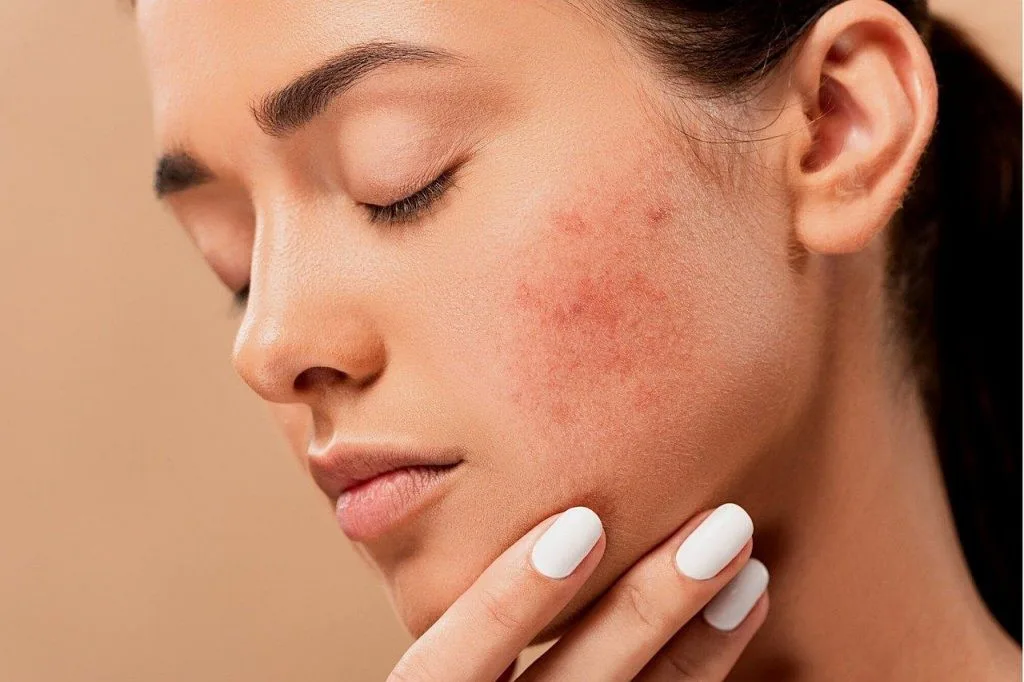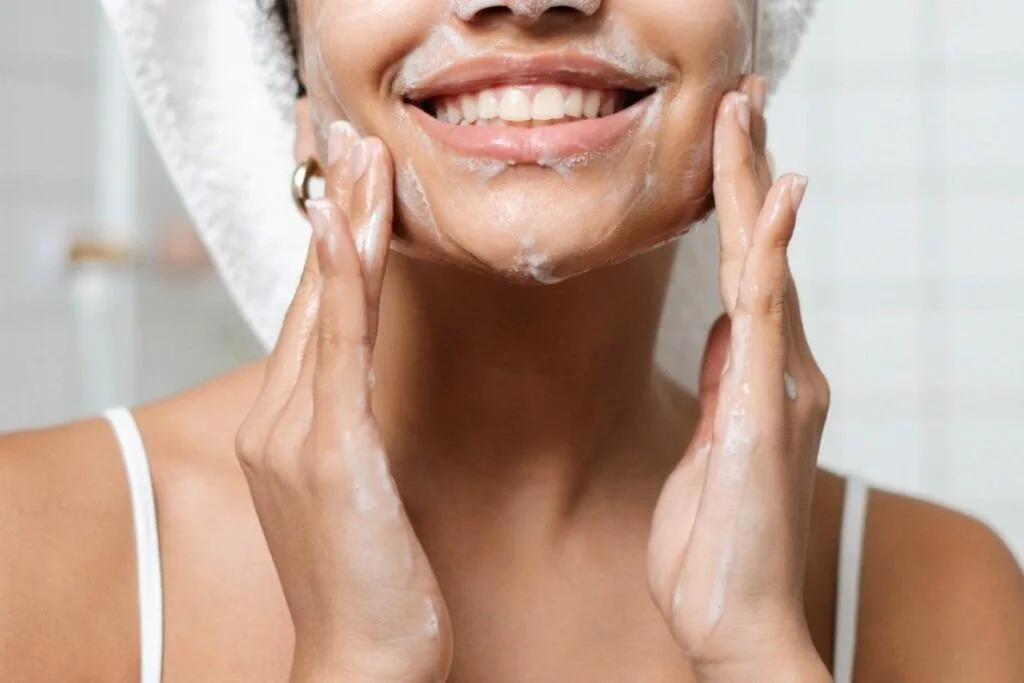Your body’s protective shield, known as the skin barrier, shields you from free radicals and potential harm caused by harsh environments. To maintain its resilience, consider using oils, ceramides, and other protective elements.
The market is busy with an array of skincare products designed to safeguard and revitalize your skin. Some focus on exfoliation, some on plumping and others on moisturizing.
What unites these diverse products is their common target: your body’s outermost layer, the skin barrier.
But what exactly is the skin barrier, what role does it play, and what factors can compromise its integrity?
In this article, we’ll help answer those questions and also explore the steps you can take to protect and restore.

What is the role of your skin barrier and why is it crucial?
Your skin is comprised of layers, each playing a vital role in safeguarding your body. The outermost layer, known as the stratum, acts like a resilient brick wall. It is composed of durable coenocytes bound together by lipid mortar. This amalgamation forms your skin barrier.
Within the “bricks” or skin cells, you’ll discover keratin and natural moisturizers. The lipid layer contains essential components such as cholesterol, fatty acids, and ceramides. This remarkably thin brick wall serves the vital function of preserving your life. Without it, harmful environmental toxins and pathogens could infiltrate your skin, leading to adverse effects within your body.
Moreover, the absence of your skin barrier would result in the escape and evaporation of water from your body, causing complete dehydration. Safeguarding your skin barrier is imperative for maintaining overall health and ensuring proper bodily function.
Some of the external and internal factors that can affect your skin barrier include
Factors, whether external or internal, that can impact your skin barrier include:
- Environments that is excessively humid or dry
- Allergens, irritants, and pollutants
- Prolonged sun exposure
- Alkaline detergents and soaps
- Exposure to harsh chemicals
- Excessive exfoliation or over-washing
- Use of steroids
- Psychological distress
The role of the acid function:
The acid mantle plays a crucial role in maintaining the health of your skin barrier. Your skin is naturally slightly acidic, forming what is known as the acid mantle. This slight acidity serves as a protective buffer, thwarting the growth of harmful bacteria, viruses, and fungi that could potentially harm your skin and lead to infections or other skin issues.
Preserving the acid mantle is particularly vital in the vicinity of wounds, as the skin’s acidity plays a key role in various biological processes during the healing journey.
In certain health conditions such as diabetes or incontinence, the skin’s acidity may undergo alterations, compromising this protective buffer. For individuals facing these conditions, experts recommend using skincare products that are slightly more acidic to help maintain skin health.
How can you tell if your skin barrier is damaged?
When your skin barrier is not functioning properly, you may be more prone to developing the following skin symptoms and conditions:
- Dry, scaly skin
- Itchiness
- Rough or discolored patches
- Acne
- Sensitive or inflamed areas
- Bacterial, viral, or fungal skin infections
How to protect and restore your skin barrier
Given the importance of maintaining your skin barrier and acid mantle, what can you do to keep them both healthy and functional? Let’s look at strategies that can help.

Simplify your skin care routine
If you’re performing a complicated daily skin regimen involving a basketful of products, you may be inadvertently weakening your skin barrier. Consider talking with a dermatologist or another skin care professional about which products are essential and most effective.
If you’re exfoliating, notice how your skin reacts to the method you use. According to the American Academy of Dermatology, those with sensitive skin and darker skin tones may want to use a soft cloth and a mild chemical exfoliate.
Some types of scrubs and brushes may temporarily damage your skin barrier.
Pay attention to pH
Your skin’s delicate acid mantle hovers around a pH of 4.7Trusted Source. But the pH of some skin products can range from 3.7 to 8.2. Researchers recommend cleansing with a product that has a pH between 4.0 and 5.0Trusted Source. Keeping your skin’s pH at a healthy level may help protect you from skin conditions like dermatitis, ichthyosis, acne, and Candida albicans infections. Although not all products list their pH, some do.
Preserving the acid mantle is particularly vital in the vicinity of wounds, as the skin’s acidity plays a key role in various biological processes during the healing journey.
In certain health conditions such as diabetes or incontinence, the skin’s acidity may undergo alterations, compromising this protective buffer. For individuals facing these conditions, experts recommend using skincare products that are slightly more acidic to help maintain skin health.
Try a plant oil to replenish your skin barrier
Certain plant oils may help repair the skin barrier and also prevent your skin barrier from losing moisture. Many of these oils have antibacterial, anti-inflammatory, and antioxidant effects, too.
Some of the most effective plant oils to consider using on your skin include:
- jojoba oil
- coconut oil
- almond oil
- argan oil
- borage oil
- rosehip oil
- sunflower oil
- soybean oil
- primrose oil
- black currant oil
There are many ways you can use plant oils on your skin. You can apply creams and lotions that contain one or more of these oils as an ingredient. Or you can pour a small amount of the oil into the palm of your hand and then massage it gently into your skin until it’s absorbed.

Try moisturizers containing hyaluronic acid, petrolatum, or glycerin
Choose for moisturizers that incorporate hyaluronic acid, petrolatum, or glycerin to address the prevalent issue of dry skin, a condition often mitigated by the regular use of moisturizers.
An occlusive moisturizer plays a crucial role in fortifying the skin barrier, minimizing water loss. These formulations create a delicate film on the skin’s surface, effectively preventing the escape of moisture.
Among the highly endorsed occlusive moisturizers, petrolatum stands out, acknowledged by experts for its potential to obstruct up to 99% of water loss from the skin, according to Trusted Source.
In addition to occlusive moisturizers, humectants also contribute to enhancing barrier function. Humectants function by attracting and binding water, sourced either from the environment or internally, into the skin barrier. Trusted Source researchers recommend products featuring hyaluronic acid, glycerin, honey, and urea for optimal results.
Not all skincare ingredients work for everyone. That’s why you may want to try a few different products to determine which one works best for keeping your skin healthy, protected, and well-moisturized.
The Bottom Line
In essence, your skin’s outermost layer, referred to as the skin barrier, shields your body from environmental threats and maintains crucial water balance.
Indications such as dryness, itching, and inflammation can signal disruptions in this vital barrier.
To restore your skin’s barrier, consider:
- Streamlining your skincare routine
- Choosing products with an appropriate pH
- Using a moisturizer containing ceramides or a humectants like hyaluronic acid
- Opting for moisturizers with petrolatum to effectively seal in moisture.
Your skin barrier serves as the first line of defense against environmental challenges. Ensuring its well-being goes beyond simple cosmetic considerations.
As it turns out you can have too much of a good thing for your face
It appears that having an excess of a beneficial substance can be detrimental to your facial skin. Dermatologists advocate for exfoliation as an effective method to eliminate dead skin cells and unveil a rejuvenated complexion. However, the surge in popularity of cell-scrubbing cleansers, toners, grains, and serums has led many beauty enthusiasts to overindulge in exfoliation, risking potential harm. The confusing aspect arises from the fact that symptoms meant to be alleviated by exfoliation, such as dry, peeling skin and breakouts, can also be indications of over-exfoliation. Determining whether you need to eliminate the accumulated layers or allow your skin to recuperate becomes a challenging task. To navigate through this confusion, surrounding insights on how to restore your skin’s well-being after unintentionally crossing the line.
Signs you’re over-exfoliating
“Over-exfoliating is one of the biggest mistakes we see people making,” says Dr. Aanand Geria, a dermatologist with Geria Dermatology. “Generally, skin should be exfoliated only one to two times per week to help expedite skin cell turnover without causing damage.” If you’ve been slathering on the exfoliating acids daily, there’s a good chance your skin is begging for a break. Eventually, your complexion can become dry and flaky. You may even develop a rash like texture, leading to uneven tone (like patchy, red blotches). Breakouts are another common reaction, especially small, rough, bumpy pimples. Luckily, it should be fairly easy to tell if you’re overdoing it on the exfoliates. Classic signs include:
- irritation
- redness
- otherwise inflamed skin
What to do if you’ve over-exfoliated
If you note any of the above reactions after exfoliating, whether from an overzealous face-scrubbing session or an application of acids, the first thing to do is stop exfoliating until your skin has healed and is at its baseline texture.“Baseline texture” will differ from person to person; in general, it just means the texture your skin had before overexposure. If you’ve always been acne prone, that will be your baseline texture.


